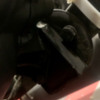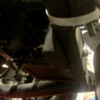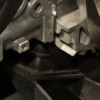First, I have never seen pronounced axle hop in a Speedster or Spyder. That includes a small handful of cars with 200+ hp, too. That said, I’m with Carey and would look at the clutch or clutch linkage (mostly suspect the Bowden tube being out of whack, but if it has a Kennedy clutch then a chattering clutch is pretty common and hard to tell from axle hop unless you see it from the side during launch or know what to feel in your butt).
What's the best way to check the mounts themselves?
Get it up on jackstands or a lift, place a long ( 3’ or more) pry bar between the frame horns and the transaxle case and try to make the front of the transaxle move up and down. If it moves more than 3/16” I would start looking for a new Rhino transaxle front mount. At the rear where the transaxle is bolted to the frame horns, again, between the frame horns and transaxle case but close to the mounting bolts. Come in from the side with an 18” pry bar and see if the transaxle rubber mounts allow more than 3/16” movement up and down. If so, replace those when you do the front mount - Get Rhino mounts for the rear, too.
Some wiggle? No wiggle? Pick up on the nosecone?
Very little wiggle, all up and down. As power is applied to the transaxle, it will try to lift the nosecone up at the front. Gene Berg (and Aircooled.net) sells a transaxle mid-mount that prevents excessive lifting of the nosecone under severe power. Since you have a Suby engine, the power might be enough to need a transaxle mid-mount to eliminate excessive nosecone lift.
Is it going to be side-to-side motion? No
Up and down? YES
Would it be obvious? Yes
Again, I would first suspect the Bowden Tube, it’s bend angle or the clutch itself, first, and then start looking at transaxle mounts.
![]() Thanks for the help, everyone.
Thanks for the help, everyone.





